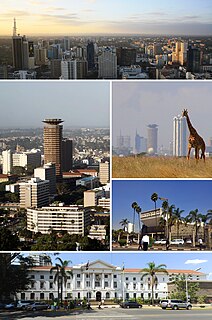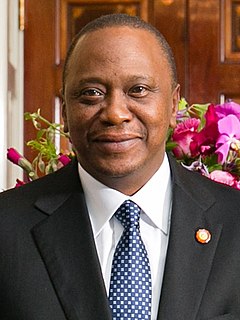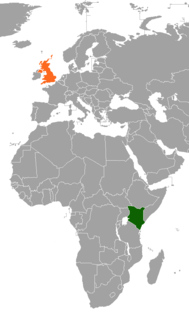
The politics of Kenya take place in a framework of a presidential representative democratic republic, whereby the President of Kenya is both head of state and head of government, and of a multi-party system in accordance with a new constitution passed in 2010.

Nairobi is the capital and largest city of Kenya. The name is derived from the Maasai phrase Enkare Nairobi, which translates to "place of cool waters", a reference to the Nairobi River which flows through the city. The city proper had a population of 4,397,073 in the 2019 census, while the metropolitan area has a population of 9,354,580. The city is commonly referred to as the Green City in the Sun.

The Kenya African National Union (KANU) is a Kenyan political party that ruled for nearly 40 years after Kenya's independence from British colonial rule in 1963 until its electoral loss in 2002. It was known as Kenya African Union (KAU) from 1944 but due to pressure from the colonial government, KAU changed its name to Kenya African Study Union (KASU) mainly because all political parties were banned in 1939 following the start is the Second World War. In 1946 KASU rebranded itself into KAU following the resignation of Harry Thuku as president due to internal differences between the moderates who wanted peaceful negotiations and the militants who wanted to use force, the latter forming the Aanake a forty, which later became the Mau Mau. His post was then occupied by James Gichuru, who stepped down for Jomo Kenyatta in 1947 as president of KAU. The KAU was banned by the colonial government from 1952 to 1960. It was re-established by James Gichuru in 1960 and renamed KANU on 14 May 1960 after a merger with Tom Mboya's Kenya Independence Movement.

The National Mall is a landscaped park within the National Mall and Memorial Parks, an official unit of the United States National Park System. It is located near the downtown area of Washington, D.C., the capital city of the United States, and is administered by the National Park Service (NPS) of the United States Department of the Interior.

The Kikuyu are a Bantu ethnic group native to Central Kenya. At a population of 8,148,668 as of 2019, they account for 17.13% of the total population of Kenya, making them the largest ethnic group in Kenya.

The Flag of Kenya is a tricolour of black, red, and green with two white edges imposed with a red, white and black Maasai shield and two crossed spears. The flag is based on that of Kenya African National Union and was officially adopted on 12 December 1963 after Kenya's independence.

Uhuru Muigai Kenyatta is a Kenyan politician who served as the fourth president of Kenya from 2013 to 2022.
Madaraka Day is a national holiday that is celebrated every 1 June in every year in the Republic of Kenya. It commemorates the day in 1963 that Kenya attained internal self rule after being a British colony since 1920. Kenya only attain partial independence on this day in 1963 and did not become a fully established republic until about a year and a half later on 12 December 1964. In recognition of the above, Kenya also celebrates Jamhuri Day on 12 December every year.

Hon Stephen Kalonzo Musyoka is a Kenyan politician who was the tenth Vice-President of Kenya from 2008 to 2013. Musyoka served in the government under the late President Daniel arap Moi and was Minister for Foreign Affairs from 1993 until 1998; subsequently, under the late President Mwai Kibaki, he was Minister of Foreign Affairs again from 2003 to 2004, then Minister of the Environment from 2004 to 2005. He was an unsuccessful candidate in the 2007 presidential election, after which he was appointed Vice-President by Kibaki in January 2008.

Wangarĩ Muta Maathai was a Kenyan social, environmental and a political activist and the first African woman to win the Nobel Peace Prize. As a beneficiary of the Kennedy Airlift, she studied in the United States, earning a bachelor's degree from Mount St. Scholastica and a master's degree from the University of Pittsburgh. She went on to become the first woman in East and Central Africa to become a Doctor of Philosophy, receiving her PhD from the University of Nairobi in Kenya.

Uhuru Park is a 12.9 hectare recreational park adjacent to the central business district of Nairobi, Kenya. It was opened to the general public by the late Mzee Jomo Kenyatta on 23 May 1969. It contains an artificial lake, several national monuments, and an assembly ground which has become a popular skateboarding spot on weekends and also a location for local skateboarding competitions, catering to Nairobi's growing skate scene.

Rizal Park, also known as Luneta Park or simply Luneta, is a historic urban park located in Ermita, Manila. It is considered one of the largest urban parks in the Philippines, covering an area of 58 hectares. The site on where the park is situated was originally known as Bagumbayan during the Spanish colonial period. It is adjacent to the historic Walled City of Intramuros.
Jamhuri Day is a national holiday in Kenya, celebrated on 12 December each year. Jamhuri is the Swahili word for "republic" and the holiday is meant to officially mark the date when Kenya became a republic on 12 December 1964, one year and six months after gaining internal self-rule on 1 June 1963 from the United Kingdom.

Hung Lau is a house built between 1905 and 1910 on former farmland in Pak Kok, Tuen Mun, Hong Kong. It was used by the Revive China Society (興中會) as a base for revolutionary activities against the Qing dynasty.

The National Museums of Kenya (NMK) is a state corporation that manages museums, sites and monuments in Kenya. It carries out heritage research, and has expertise in subjects ranging from palaeontology, archeology, ethnography and biodiversity research and conservation. Its headquarters and the National Museum are located on Museum Hill, near Uhuru Highway between Central Business District and Westlands in Nairobi. The National Museum of Kenya was founded by the East Africa Natural History Society (E.A.N.H.S.) in 1910; the society's main goal has always been to conduct an ongoing critical scientific examination of the natural attributes of the East African habitat. The museum houses collections, and temporary and permanent exhibits. Today the National Museum of Kenya manages over 22 regional museums, many sites, and monuments across the country.

The First World War centenary was the centenary of the First World War, which began on 28 July 2014 with a series of commemorations of the outbreak of the war organised across the continent of Europe, and ended on 11 November 2018 with the centenary of the 1918 Armistice, during which multiple commemorations were held globally, including an international ceremony in Paris.

Elizabeth II was Queen of Kenya from 1963 to 1964, when Kenya was an independent sovereign state with a constitutional monarchy. She was also the sovereign of the other Commonwealth realms, including the United Kingdom. Her roles as the Kenyan head of state were delegated to the governor-general of Kenya.

Kenya–United Kingdom relations are bilateral relations between Kenya and the United Kingdom. The interactions between the two states have been positive and friendly since Kenya's independence in 1963. Both the UK and Kenya are members of the Commonwealth of Nations and engage with each other regularly on matters of military, economic and cultural importance. Kenya retains many aspects of British culture and governance, such as continuing to use English within administration, education and the law, driving on the left, hosting a diaspora community of Britons, and having a large Protestant population. The British military continues to play an important role in the country with Kenya hosting the UK's largest base in Africa, which provides vital anti-terrorism training to the Kenyan police. The British royal family, in particular the Queen has very close personal ties to the country. Elizabeth II was in Kenya when she received news that her father King George VI had died, and has made multiple state visits throughout her reign. Recently, to mark the 2022 Platinum Jubilee, Prince Edward visited the country to reinforce ties and celebrate Kenya's historic and current relationship with the UK.British tourism and finance are significant contributors to the Kenyan economy, with 100,000 British people visiting the country ever year for its national parks and wildlife.

The Mombasa tusks, also referred to as Mapemba ya Ndovu or Pembe za Ndovu, form a monument over Moi Avenue, a major thoroughfare in Mombasa, Kenya. Built in the 1950s to commemorate visits by the British royal family, the monument originally comprised two wooden structures resembling tusks; nowadays, there are four aluminium tusks in an M shape. The monument is under the jurisdiction of the National Museums of Kenya in addition to the city's municipal government.
















